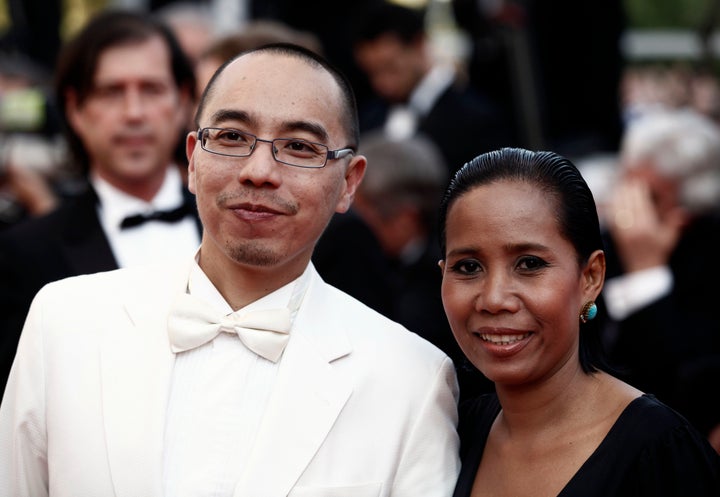
Apichatpong Weerasethakul's films have never given up their meanings easily. His latest, "Uncle Boonmee Who Can Recall His Past Lives," won the Palme d'Or at Cannes last year but nevertheless confounded many French critics.
The mystical story of a man dying from kidney failure who sees his dead wife and son -- the latter has turned into a gorilla -- manages to make a picaresque stop at a river to watch a princess turn into a fish before returning to Boonmee's family as it makes a misty procession into a cave in the jungle.
Weerasethakul's films are undeniably art but divide cinema-lovers. A new solo show called "Primitive" at the New Museum -- his first in New York -- will likely have the same effect on museumgoers. The exhibition opens Thursday and runs until July 3.
While developing "Uncle Boonmee" in 2009, the Thai director received a commission from a German museum to create a video installation about the the isolated and cursed village of Nabua. While "Primitive" has been deemed fit for a museum and "Uncle Boonmee" for the theater, they cover much of the same ground. Both examine the sensual delights and political nightmares of life in rural Thailand, and both resist simple interpretations.
Nabua sits in a region of northeast Thailand called Isan. That region was wracked by internecine violence during the 1970s and 1980s, as right-wing government soldiers and militia brutally repressed a communist uprising spilling over from nearby Laos. Family turned against family, and farmers accused of ties to communism spirited away into the jungle.
Born in the modern metropolis of Bangkok, Weerasethakul soon moved with his family to Isan, where he was raised. Isan looms large in the Thai imagination as a preserve of traditional values, but it is also seen as something of a backwater. In Thai movies or soap operas, Weerasethakul told HuffPost, "Isan people always play driver or servant or housemaid, always the secondary role."
During his months in Nabua, both "Uncle Boonmee" and the "Primitive" installation came into focus -- the former as a narrative and the latter as a quasi-documentary work of non-linear art. His portraits of the region's people present them in a gentle, humanizing light, but also channel their beliefs in the supernatural.
"I could see more of the movie," Weerasethakul said of "Uncle Boonmee." "I had a script ready [that] I was developing during staying in this village. So even though there’s a text already, now with the village, you can see what kind of architecture and light" he wanted to use.
The trailer for "Uncle Boonmee."
Weerasethakul stayed in Nabua for four months with his crew. "They don’t want to remember," he said. An outsider asking questions can get some of the village's residents to open up, almost as a form of therapy, but by and large "they don’t really hate each other, but just don’t talk about it."
"It's quite a bleak landscape," he said. "You know that there’s some bad things underground, like there’s some people killed here and there."
He conducted hundreds of hours of on-camera interviews with the village elders, but it was the sons of that generation who disappeared during the insurgency that fascinated him. He gained their confidence and got them to open up on camera.
"I feel more at ease with the teens, the way they dress, the fashion, the music that they listen to, so it doesn’t feel forced for me," Weerasethakul said.
The result is an installation that, while not explicitly political, spins the unnerving story of teenagers discovering the past and the future. Weerasethakul makes this element of the installation quite literal: He made the teens build a time-travel spaceship, and he filmed them inside of it.
"We created together," Weerasethakul said. To live in the village was to get to know the kids' personality, "so it’s like casting in a way, but real life casting."
Between nine screens and four rooms, the installation creates spaces for a project that is both documentary and fictional all at once. Weerasethakul got the village sons to open up in their daily lives, screwing around beside a lake and joyfully dancing in the back of a pickup, but he also convinced them to serve as actors in the ghostly tale of the time-travelers and the glowing lights they encounter in the forest at night.
"Primitive," as with all of his films, has no single, didactic aim.
"I hope that with this one people may be inspired to look into what’s going on in this village. But for me I really have no preference, it’s really free," he said.
The political element is nevertheless inescapable, especially as Thailand continues to be shadowed by the legacy of a 2006 coup, despite the country's tourism-friendly image. In the wake of protests that killed 91 last year and in advance of July elections, the country's army has made repeated threats against the populist "red shirt" movement that draws many of its supporters from Isan.
The trajectories of the teenagers Weerasethakul befriended for "Primitive" match those of many from the poor region of Isan. Some have moved to the cities for opportunity, some have been conscripted into the army, and some are in jail, Weerasethakul said.
Nabua's villagers still need a spaceship, Weerasethakul believes. And, he added, "I think we all do."
